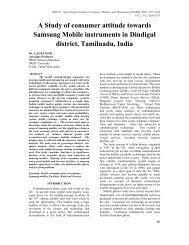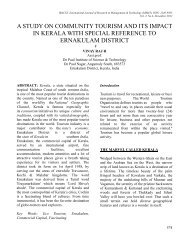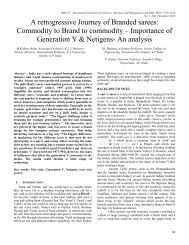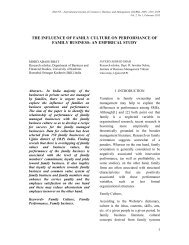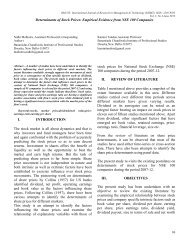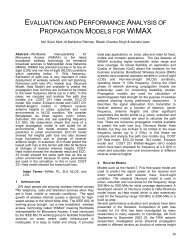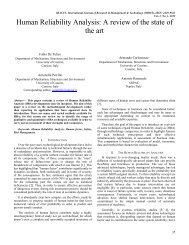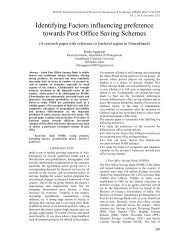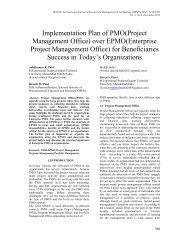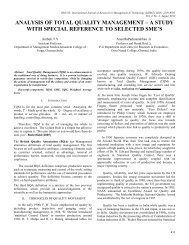Fractal Geometry in Image Processing
Fractal Geometry in Image Processing
Fractal Geometry in Image Processing
Create successful ePaper yourself
Turn your PDF publications into a flip-book with our unique Google optimized e-Paper software.
IRACST- International Journal of Research <strong>in</strong> Management & Technology (IJRMT), ISSN: 2249-9563<br />
Vol. 2, No. 1, 2012<br />
Conversely, the self-similarity dimension D can be<br />
obta<strong>in</strong>ed as<br />
D = log(N) / log(l/r)<br />
……………… (1.2)<br />
Here D is also known as fractal dimension (Luo, 1998)<br />
1.5 Applications of fractals<br />
Figure 1.1: Representation of Koch curve <strong>in</strong> vary<strong>in</strong>g scales<br />
For construct<strong>in</strong>g Koch's curve, an <strong>in</strong>itiator and<br />
generator are needed. For the Koch curve, <strong>in</strong>itiator is a l<strong>in</strong>e<br />
segment. The generator is a set of four segments, each<br />
segment, one-third the length of the <strong>in</strong>itiator, arranged as<br />
shown <strong>in</strong> Figure 1.1. After the first replacement, the new<br />
figure is 4/3 as long as the orig<strong>in</strong>al l<strong>in</strong>e and has an<br />
undifferentiable po<strong>in</strong>t at the peak of the equilateral triangle.<br />
After the second replacement, the figure is 4/3 the length of<br />
the figure created by the first replacement and has four<br />
undifferentiable po<strong>in</strong>ts. Eventually, after <strong>in</strong>f<strong>in</strong>ite<br />
replacements, the figure has so many triangle peaks that<br />
every po<strong>in</strong>t is undifferentiable.<br />
1.3 Natural fractals - statistical self-similarity<br />
The similarity method for calculat<strong>in</strong>g fractal<br />
dimension works for a mathematical fractal, like Koch<br />
curve which is composed of a certa<strong>in</strong> number identical<br />
versions of itself. This is not the case with natural objects.<br />
Such objects show only statistical self-similarity. A<br />
mathematical fractal has an <strong>in</strong>f<strong>in</strong>ite amount of details. This<br />
means that magnify<strong>in</strong>g it adds additional details , thereby<br />
<strong>in</strong>creas<strong>in</strong>g overall size. In non fractals, the size rema<strong>in</strong>s the<br />
same <strong>in</strong> spite of applied magnification. The graph of log<br />
(fractal's size) aga<strong>in</strong>st log (magnification /actor) gives a<br />
straight l<strong>in</strong>e. If the object is nonfractal, then this l<strong>in</strong>e is<br />
horizontal s<strong>in</strong>ce the size does not change. If the object is<br />
fractal, the l<strong>in</strong>e is no longer horizontal s<strong>in</strong>ce the size<br />
<strong>in</strong>creases with magnification. The geometric method of<br />
calculat<strong>in</strong>g fractal dimension is by comput<strong>in</strong>g the slope of<br />
the above plotted l<strong>in</strong>e.<br />
1.4 Concept of fractal dimension<br />
<strong>Fractal</strong> geometry characterizes the way <strong>in</strong> which a<br />
quantitative dataset grows <strong>in</strong> mass, with l<strong>in</strong>ear size. The<br />
fractal dimension (D) is a measure of non-l<strong>in</strong>ear growth,<br />
which reflects the degree of irregularity over multiple<br />
scales. It is very often a non <strong>in</strong>teger and is the basic<br />
measure of fractals. For a D-dimensional object, the<br />
number of identical parts, N divided by a scale ratio, r can<br />
be calculated from<br />
N = l/r D<br />
……………… (1.1)<br />
<strong>Fractal</strong>s can be used to model the underly<strong>in</strong>g<br />
process <strong>in</strong> a variety of<br />
applications. A range of fractal analytical methods are used<br />
to characterise the fractal behaviour of the World Wide<br />
Web traffic. A realistic queu<strong>in</strong>g model of Web traffic is<br />
developed based on fractal theory that provides analytical<br />
<strong>in</strong>dications of network bandwidth dimension<strong>in</strong>g for Internet<br />
service<br />
providers<br />
(http://vvww.cs.bu.edu/facultv/crovella/paper-archive/selfsim/paper.html).<br />
Another application is to characterize the<br />
fractal nature of the entire system work<strong>in</strong>g <strong>in</strong> a LAN<br />
environment. Research is currently go<strong>in</strong>g on <strong>in</strong> the design<br />
of an airborne conformal antenna us<strong>in</strong>g fractal structure that<br />
offers multiband operation<br />
(http://www.fractenna.com/nca_faq.html). <strong>Fractal</strong> geometry<br />
is used for understand<strong>in</strong>g and plann<strong>in</strong>g the physical form of<br />
cities. It helps to simulate cities through computer graphics.<br />
The structural properties of fractals can be used <strong>in</strong> the<br />
architectural designs and also to model the morphology of<br />
surface growth. <strong>Fractal</strong> theory can be applied to a wide<br />
range of issues <strong>in</strong> chemical sciences like aggregation<br />
phenomena Reposition and diffusion processes, chemical<br />
reactivity etc. The geological features like rock breakage,<br />
ore and petroleum concentrations, seismic activity and<br />
tectonics, and volcanic eruptions can be studied us<strong>in</strong>g their<br />
fractal characteristics. In biology, it has been found that the<br />
DNA of plants and animal cells does not conta<strong>in</strong> a complete<br />
description of all growth patterns, but conta<strong>in</strong>s a set of<br />
<strong>in</strong>structions for cell development that follows a fractal<br />
pattern. <strong>Fractal</strong> geometry can be used <strong>in</strong> an analytical way<br />
to predict outcomes, to generate hypotheses, and to design<br />
experiments <strong>in</strong> biological systems <strong>in</strong> which fractal<br />
properties are most seen.<br />
Man-made objects are well def<strong>in</strong>ed us<strong>in</strong>g Euclidean<br />
geometry whereas natural objects are better modelled by<br />
fractal geometry. After the <strong>in</strong>troduction of fractal geometry,<br />
its effect on various natural phenomena were studied.<br />
Goodchild (1980) studied the relation between fractal and<br />
geographical measure and po<strong>in</strong>ted out that the fractal<br />
dimension can be used to predict the effect of cartographic<br />
generalization and spatial sampl<strong>in</strong>g. In cartography, Dutton<br />
(1981) used the properties of irregularity and self similarity<br />
of fractal to develop an algorithm to enhance the detail of<br />
digitized curves by alter<strong>in</strong>g their dimensionality <strong>in</strong> a<br />
parametrically controlled self similar fashion. Batty (1985)<br />
showed a number of examples of simulated landscape,<br />
mounta<strong>in</strong>scape and other graphics generated by us<strong>in</strong>g the<br />
111



